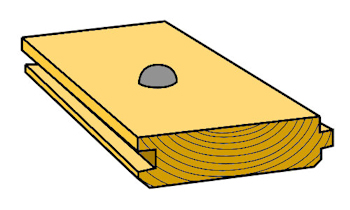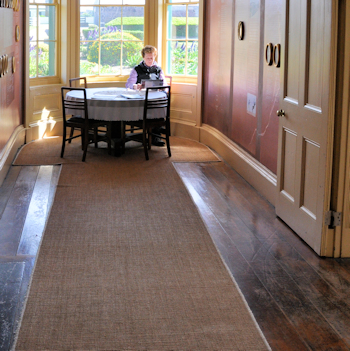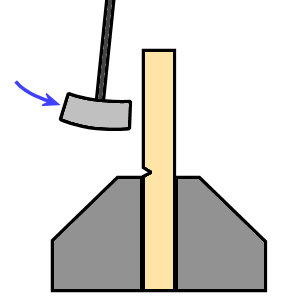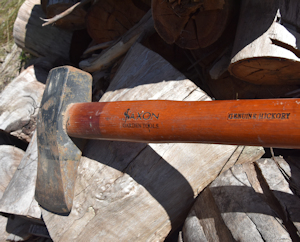Hardness and toughness
Hardness and toughness are properties that relate to a piece of timber’s ability to stand up to heavy duty wear and tear in service. Nonetheless, they are not the same thing, and are used to rate different aspects of the wood fibres’ performance when subjected to impacts, indents and abrasion.
Hardness

measuring the force required to embed a steel ball
halfway into the surface of the timber
Hardness is the ability of wood to resist indentation. It is often used as a comparison between species when deciding on which one to choose for a floor surface or other application that is subject to abrasion or scraping.
The most common method of measurement is the Janka hardness test. This involves pressing a steel ball with a diameter of 11.18 mm into the timber until it reaches its halfway point, producing a cavity of 1 square centimetre in the surface. The pressure required to push the ball in to this depth is measured in kilonewtons (kN).
Note that although hardness is important in many industrial applications and high traffic areas, it’s not always the main consideration in a solid timber floor, especially in residential buildings. For example, Baltic pine has been used successfully as a flooring product for over 200 years, but it’s actually quite soft.

providing protection from scuffs and indentations
It is possible to protect the floor with rugs and hallway runners in high traffic areas, although some people prefer to simply let the floor wear naturally and develop its own character over time.
Below are the hardness figures for a range of timber species commonly used in solid timber floors. The dry density figure is also shown for each species to illustrate the relationship between density and hardness. The green density figures are not shown here, because virtually all timber flooring products these days are supplied seasoned. However, it’s worth mentioning that cypress pine strip flooring was traditionally used in its green state because it has such a low shrinkage rate and its properties remains very stable as it dries.
The following figures are taken from the reference book Wood in Australia (K.R. Bootle, Forestry Commission of NSW, 1983). The species are ranked from hardest to softest.
| Hardness figures for flooring timbers | ||
| Timber species | Density – dry (kg/m3) |
Hardness – dry (Janka - kN) |
| Grey gum | 1080 | 14 |
| Red ironbark | 1130 | 13 |
| Spotted gum | 950 | 11 |
| Brushbox | 900 | 9.5 |
| Blackbutt | 900 | 9.1 |
| Tallowwood | 990 | 8.6 |
| Jarrah | 820 | 8.5 |
| Cypress pine | 680 | 6.5 |
| American white oak | 750 | 6.0 |
| Alpine ash | 620 | 4.9 |
| Baltic pine | 500 | 2.1 |
Toughness

measuring the force required to fracture
a piece of timber with a falling pendulum
Toughness, also called impact strength, is the ability to withstand shocks and blows. The most common method used to measure toughness in timber is the Izod impact test. Pre-notched specimens of each species are broken by a falling pendulum, and the energy required to fracture the fibres is measured in newton metres (Nm).
Toughness is an important property for any timber component that needs to absorb sudden shocks or impacts. Traditionally, Russian and European ships that were built for Arctic waters often used Australian ironbark sheathing in the hull to help break up the pack ice without over-stressing the other structural members.
Tool handles, particularly those used in hammers, axes, picks and mattocks, also need high impact strength to resist cracking or splitting when subjected to shock loads.
Some reference tables of wood properties list the specific toughness values for different timber species. These can be found in various textbooks, on-line resources and Australian Standards – in particular: AS1720.2 SAA Timber Structures Code Part 2: Timber Properties.

a tool used to split firewood
However, because of the variations that can occur in individual pieces of the same species, it is common for reference tables to show classifications such as Low, Medium and High toughness ratings, rather than quote actual figures. The examples below show the toughness classifications listed in the Timber Manual Datafile (P1) – Timber Species and Properties, published by the National Association of Forest Industries, in association with the Forest and Wood Products Research and Development Corporation. These groupings are based on the following impact strength values:
-
Low – up to 15 Nm
-
Medium – 15 to 25 Nm
-
High – 25 Nm and above.
| Timber species | Toughness |
| Grey ironbark | High |
| Spotted gum | High |
| Brushbox | Medium |
| Blackbutt | Medium |
| Sydney blue gum | Medium |
| Mountain ash | Medium |
| Merbau | Medium |
| Jarrah | Low |
| White cypress pine | Low |
| Douglas fir | Low |
| Western red cedar | Low |